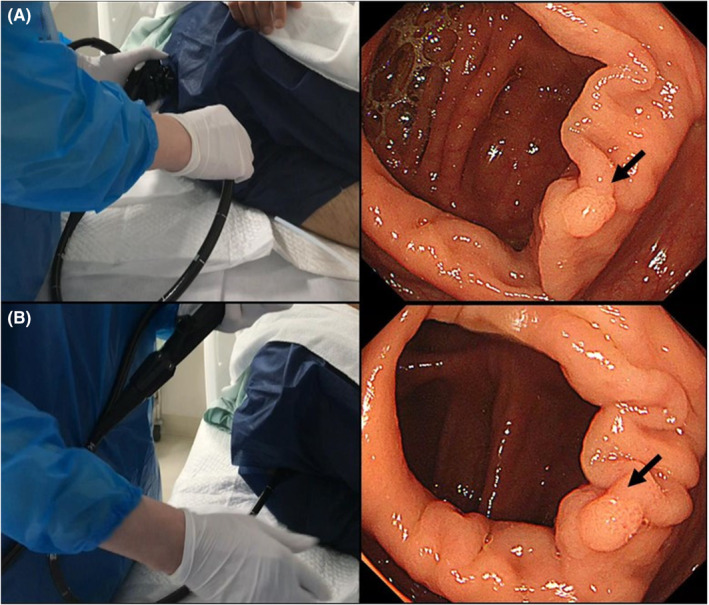Abstract
Free full text

Usefulness of unwinding the colonoscope shaft loop via the universal cord for colorectal endoscopic resections
Associated Data
Key Clinical Message
The colonoscope shaft loop can be unwound by establishing a loop in the universal cord of the colonoscope to maintain the same endoscopic view during colorectal endoscopic resections.
1. INTRODUCTION
Endoscopists must rotate the endoscope to bring the lesion closer to the forceps hole (typically in a 5–6 o'clock direction) while performing endoscopic colorectal resections. 1 , 2 During this process, a loop is sometimes created in the colonoscope shaft and the endoscopist's hands frequently need to maintain the loop to keep the same endoscopic view, making free hand movement difficult.
Unwinding the colonoscope shaft loop via the universal cord can be used for colorectal endoscopic treatment, such as colorectal endoscopic resections, because it frees the endoscopist's hands while maintaining the same endoscopic view during colorectal endoscopic resections (Figure 1, Video 1).

Colonic polypectomy case depicting the unwinding usage of the colonoscope shaft loop via the universal cord. Polyp of macroscopic type 0–Is, 5 mm in size, and located in the proximal ascending colon; arrow indicates the polyp. (A) Endoscope must be rotated counterclockwise to bring the polyp to the 5 o'clock direction, restricting the endoscopist's hand movement. (B) After unwinding the colonoscope shaft loop via the universal cord, the polyp remains in the 5 o'clock direction; however, the endoscope returns to a neutral position, enabling free hand movement.
mm in size, and located in the proximal ascending colon; arrow indicates the polyp. (A) Endoscope must be rotated counterclockwise to bring the polyp to the 5 o'clock direction, restricting the endoscopist's hand movement. (B) After unwinding the colonoscope shaft loop via the universal cord, the polyp remains in the 5 o'clock direction; however, the endoscope returns to a neutral position, enabling free hand movement.
Colonic polypectomy case using the unwinding of the colonoscope shaft loop via the universal cord.
AUTHOR CONTRIBUTIONS
Taiji Yoshimoto: Conceptualization; resources; supervision; writing – original draft; writing – review and editing. Hiroshi Takihara: Conceptualization; supervision; writing – review and editing. Ryuichi Yamamoto: Conceptualization; resources.
FUNDING INFORMATION
No funding was received.
CONFLICT OF INTEREST STATEMENT
The authors have no conflicts of interest to declare.
CONSENT
Written informed consent was obtained from the patient to publish this report in accordance with the journal's patient consent policy.
ACKNOWLEDGMENTS
We thank the Japan Endoscopy Team for their great support.
Notes
Yoshimoto T, Takihara H, Yamamoto R. Usefulness of unwinding the colonoscope shaft loop via the universal cord for colorectal endoscopic resections. Clin Case Rep. 2024;12:e9461. 10.1002/ccr3.9461 [CrossRef] [Google Scholar]
DATA AVAILABILITY STATEMENT
The data that support the findings of this study are available from the corresponding author upon reasonable request.
REFERENCES
Articles from Clinical Case Reports are provided here courtesy of Wiley
Similar Articles
To arrive at the top five similar articles we use a word-weighted algorithm to compare words from the Title and Abstract of each citation.
Guidelines for Colorectal Cold Polypectomy (supplement to "Guidelines for Colorectal Endoscopic Submucosal Dissection/Endoscopic Mucosal Resection").
Dig Endosc, 34(4):668-675, 01 Mar 2022
Cited by: 16 articles | PMID: 35113465
Review
Case of Colorectal Cancer After Cold Snare Polypectomy Successfully Salvaged on Endoscopic Submucosal Dissection.
Cureus, 12(10):e11182, 26 Oct 2020
Cited by: 2 articles | PMID: 33262917 | PMCID: PMC7689808
"Transanal endoscopic microsurgery" with a flexible colonoscope (F-TEM): a new endoscopic treatment for suspicious deep submucosal invasion T1 rectal carcinoma.
Surg Endosc, 37(7):5714-5718, 25 May 2023
Cited by: 3 articles | PMID: 37231174
A balloon-assisted endoscopic submucosal dissection using long colonoscope and guidewire.
DEN Open, 4(1):e259, 15 Jun 2023
Cited by: 0 articles | PMID: 37333980 | PMCID: PMC10272917

 1
1


